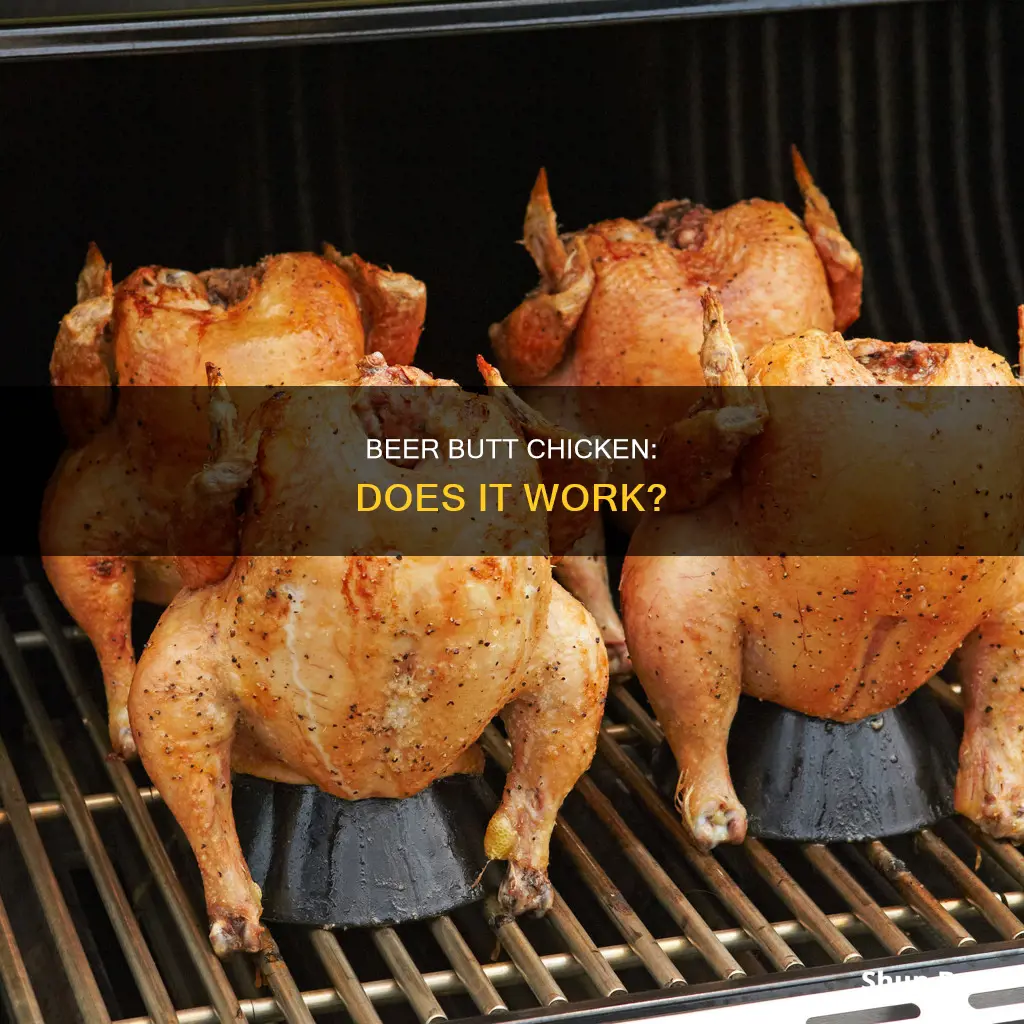
Beer can chicken is a cooking method where a half-full can of beer is inserted into a chicken's body cavity and placed on a grill. The theory is that the beer will cook off and transfer flavour and moisture to the meat, creating a tender and juicy chicken. However, there is much debate over whether this method actually works, with some claiming that it is a hoax and that the beer does not get hot enough to boil and add moisture to the meat. Others argue that it is a fun and convenient way to cook a chicken, even if it doesn't necessarily improve the taste or texture.
| Characteristics | Values |
|---|---|
| Overall Taste | No better or worse than average barbecued chicken |
| Moisture | Does not make the chicken moister |
| Flavor | Does not flavor the chicken |
| Safety | Potentially unsafe due to ink, plastic, and metal from the can |
| Cooking Dynamics | Hinders even heat distribution |
What You'll Learn

Beer butt chicken may result in dry meat
The key issue lies in the science of cooking chicken. White meat and dark meat have different optimal cooking temperatures. White meat is fully cooked and safe to eat at lower temperatures, around 160°F, while dark meat requires higher temperatures of at least 165°F. In the beer butt chicken method, the white meat is at the uppermost part of the chicken, receiving most of the heat. This uneven heat distribution can result in dry white meat and undercooked dark meat.
Furthermore, the beer in the can rarely reaches the boiling point, which is necessary for it to add moisture to the meat. The can is placed inside the chicken's cavity, which acts as an insulator and prevents the beer from getting hot enough. Experiments have shown that the average high temperature of the beer in these cases is only around 130°F, significantly below the boiling point.
To avoid dry meat when using the beer butt chicken method, it is crucial to monitor the temperature carefully and ensure even heat distribution. Pre-heating the liquid in the can or using a beer can chicken roaster with a drip pan can also help mitigate the risk of dry meat. Additionally, some recipes suggest poking holes in the beer can to allow steam to escape and moisten the meat.
While the beer butt chicken method may not be the most effective for ensuring moist meat, it does have its advantages. It provides a beautiful, well-colored, and crunchy skin. Additionally, the beer and seasonings can impart delicate flavors to the meat closest to the bones. However, to achieve juicy and tender meat, alternative cooking methods such as spatchcocking or butterflying the chicken may be more successful.
Beano and Beer: Does the Enzyme Work?
You may want to see also

The beer doesn't add flavour
Beer butt chicken, or beer can chicken, is a barbecued chicken dish cooked using a method of indirect grilling. The method involves placing an open can of beer or other canned beverage inside the chicken's cavity and using it to hold the chicken vertically while it cooks. The process is believed to add moisture to the chicken, with some suggesting that the steam from the beer adds flavour to the dish. However, there is debate around the effectiveness of this method in adding flavour and moisture to the chicken.
The idea that beer butt chicken enhances flavour is questionable. Firstly, the beer itself does not come into direct contact with the meat. The beer is contained within the aluminium can, which acts as a barrier, preventing the beer from touching the chicken. As a result, there is no transfer of flavour from the beer to the chicken.
Additionally, the beer in the can rarely reaches a high enough temperature to produce significant steam. The boiling point of water is 212°F, and the beer must reach this temperature to create enough steam to impact the chicken's flavour. However, the beer can is placed inside the chicken's cavity, which acts as an insulator, preventing the beer from reaching the required temperature. Experiments have shown that the average high temperature of the beer in beer butt chicken preparations is only 130°F, significantly below the boiling point.
Furthermore, the beer can hinder even heat distribution within the chicken. The can blocks heat from reaching the centre of the chicken, leading to potential issues with burning the outside or undercooking the inside. This uneven heat distribution can also affect the moisture content of the chicken. The white meat in the uppermost part of the chicken is more delicate and prone to drying out due to the higher heat exposure. Conversely, the dark meat in the lower part of the chicken, wrapped around the cold beer can, may not reach the desired temperature, resulting in slower cooking and moisture loss.
While the concept of beer butt chicken may be intriguing, the reality is that the beer itself does not significantly contribute to the flavour of the dish. The flavour and moisture of the chicken are primarily influenced by the cooking process and other seasonings used.
Beer Sleeves: Do They Keep Drinks Cool?
You may want to see also

The beer doesn't add moisture
The beer can inside the chicken's cavity doesn't add any moisture to the chicken. The beer can never gets hot enough to boil and create steam, which means it can't add any moisture to the chicken. The chicken insulates the can, keeping it from reaching a high enough temperature to create steam. This is further evidenced by the amount of beer left in the can once it is removed after roasting. The beer can also block heat from reaching the centre of the chicken, which can lead to uneven cooking and dry meat.
The beer can chicken method involves placing a half-full can of beer inside the cavity of a chicken, which then roasts vertically on top of the can. The theory is that the moisture from the beer will keep the white meat juicy. However, this is not what happens in practice. The beer never comes into contact with the meat and any flavour that might be imparted is minimal and limited to the meat right on the rib cage and bones.
The reason the beer never reaches boiling is that the can is placed inside the chicken, which acts as an insulator. The chicken meat insulates the beer can, keeping it from reaching a high enough temperature to create steam. This means that the beer can't add any moisture to the chicken. Additionally, the beer can block heat from reaching the centre of the chicken, which can lead to uneven cooking and dry meat.
The beer can chicken method may also be unsafe. The can can stick to the chicken, making it tricky to remove from the grill. Spilled beer and chicken fat can cause a mess and potentially lead to burns. The ink on the cans and the plastic liners are also not food-grade and may not be safe at cooking temperatures.
Beer Slug Traps: Do They Work?
You may want to see also

The beer can hinder even heat distribution
The beer can chicken method involves placing a half-full can of beer inside the cavity of a chicken, which is then roasted vertically on a grill. However, one of the main drawbacks of this technique is that the beer can hinders even heat distribution within the chicken.
The presence of the beer can in the centre of the chicken creates a thick, meaty barrier that blocks heat from reaching the interior of the bird. This can result in uneven cooking, with the outside of the chicken becoming burnt while the inside remains undercooked. The white meat in the uppermost part of the chicken is particularly susceptible to overcooking, as it absorbs heat more easily and is typically thicker than the hindquarters.
The beer can also acts as a cold sink, slowing down the cooking of the dark meat. The dark meat needs to reach a higher temperature than the white meat to be considered safe, and the beer can prevents this area from heating up effectively. Additionally, the natural juices of the chicken tend to drain out and move downwards due to gravity, further drying out the white meat.
The beer can chicken method may result in a beautifully browned and crunchy skin, but the uneven heat distribution caused by the presence of the beer can makes it difficult to achieve the desired internal temperatures for both the white and dark meat.
To ensure even cooking and prevent overcooking or undercooking, alternative methods such as butterflying or spatchcocking the chicken are recommended. These techniques allow for more even heat distribution and faster cooking times, resulting in a juicier and more evenly cooked bird.
Energy and Alcohol: Do Beer and Red Bull Work?
You may want to see also

Safety concerns
There are several safety concerns associated with beer butt chicken, which may cause cooks to opt for alternative methods, such as spatchcocking, brining, or using a chicken throne or rack.
Firstly, there is a risk of the chicken falling over, which could result in a hot beer spill. This can be mitigated by using a beer can chicken roaster, which holds the bird upright and collects drippings in a pan.
Secondly, there are concerns about the potential for toxins to leech into the chicken from the metal can, paint, and plastic lining. The high temperatures involved in grilling could cause the can's coating to break down and release chemicals, which may contaminate the food. However, some sources argue that the amount of toxins transferred is minimal and unlikely to cause harm. One source suggests using a jar or glassware instead of a can to avoid this issue.
Thirdly, the beer can chicken method may hinder even cooking and result in dry meat. The can acts as a thermal mass, preventing heat from entering the cavity and cooking the chicken from the inside. This can lead to overcooking the exterior before the interior is safely cooked.
Lastly, there is a risk of flare-ups due to dripping fat. This can be mitigated by using a drip pan to catch the hot fat and prevent it from flowing onto the grill or deck.
Beer Bar Memberships: Are They Worth the Cost?
You may want to see also
Frequently asked questions
Beer butt chicken is a cooking method that involves placing a half-full can of beer inside a chicken's body cavity and roasting it vertically. While it may result in a well-coloured skin, the beer does not add significant moisture or flavour to the meat. The beer in the can does not get hot enough to boil and produce steam, which is necessary for adding moisture to the chicken.
The presence of the beer can may hinder even heat distribution, leading to either a burnt exterior or an undercooked interior. The can blocks heat from reaching the centre of the chicken, and the white meat in the uppermost area is more susceptible to drying out.
There are safety concerns associated with beer butt chicken. The ink and coatings on beer cans can release chemicals and toxins into the meat at high temperatures. Additionally, the plastic lining in cans may not be safe for cooking temperatures.
Instead of using a beer can, consider using a stainless steel cup or a ceramic holder designed specifically for this purpose. You can also try spatchcocking the chicken, which involves removing the spine and butterflying the bird to achieve more even cooking and a crispier skin.
The type of beer used is unlikely to make a significant difference in flavour. Beer is mostly water, and the small amount of flavourful components (sugar, proteins, acids, minerals) only make up about 2% of the beverage.







